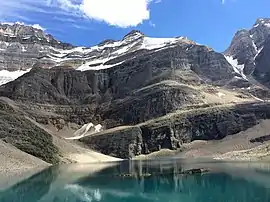Glacier Peak (Canadian Rockies)
Glacier Peak is located on the border of Alberta and British Columbia in the Canadian Rockies. It was named in 1894 by Samuel E.S. Allen in reference to the glacier on the northern side of the mountain.[1][2]
| Glacier Peak | |
|---|---|
 Glacier Peak (centered) with Mount Lefroy in upper left and Ringrose Peak in upper right as seen from Lake Oesa | |
| Highest point | |
| Elevation | 3,302 m (10,833 ft) [1][2] |
| Prominence | 72 m (236 ft) [2] |
| Coordinates | 51°21′03″N 116°17′04″W [3] |
| Geography | |
 Glacier Peak Location in Alberta and British Columbia | |
| Country | Canada |
| Provinces | Alberta and British Columbia |
| Parent range | Canadian Rockies |
| Topo map | NTS 82N/08 |
| Climbing | |
| First ascent | 1909 V. Fynn; A. Hart; C. Richardson; L. Wilson[1] |
_BHL48165239.jpg.webp)
Glacier Peak in upper right corner
Geology
Glacier Peak is composed of sedimentary rock laid down during the Precambrian to Jurassic periods.[4] Formed in shallow seas, this sedimentary rock was pushed east and over the top of younger rock during the Laramide orogeny.[5]
Climate
Based on the Köppen climate classification, Glacier Peak is located in a subarctic climate with cold, snowy winters, and mild summers.[6] Temperatures can drop below −20 C with wind chill factors below −30 C.
See also
- List of mountains in the Canadian Rockies
- List of peaks on the British Columbia–Alberta border
- List of mountains of Alberta
- Mountains of British Columbia
References
- "Glacier Peak". PeakFinder.com. Retrieved 2019-08-17.
- "Glacier Peak". Bivouac.com. Retrieved 2010-02-11.
- "Glacier Peak". BC Geographical Names. Retrieved 2014-07-21.
- Belyea, Helen R. (1960). The Story of the Mountains in Banff National Park (PDF). parkscanadahistory.com (Report). Ottawa: Geological Survey of Canada. Archived (PDF) from the original on 2015-10-02. Retrieved 2019-09-13.
- Gadd, Ben (2008), Geology of the Rocky Mountains and Columbias
- Peel, M. C.; Finlayson, B. L.; McMahon, T. A. (2007). "Updated world map of the Köppen−Geiger climate classification". Hydrol. Earth Syst. Sci. 11: 1633–1644. ISSN 1027-5606.
External links
- Parks Canada web site: Yoho National Park
- Parks Canada web site: Banff National Park
This article is issued from Wikipedia. The text is licensed under Creative Commons - Attribution - Sharealike. Additional terms may apply for the media files.